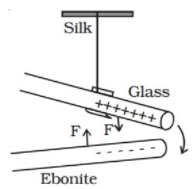Static Electricity Class-8th Goyal Brothers Physics Solutions Chapter-8 (Electricity), unit-1 (Static Electricity). We Provide Step by Step Answers of Objective, True False, Incorrect and Correct, Fill in the blanks, Match the following , Short/Long Answer Type of Chapter-8 (Electricity), unit-1 (Static Electricity) Visit official Website CISCE for detail information about ICSE Board Class-8.
Static Electricity Class-8th Goyal Brothers ICSE Physics Solution Chapter-8 Unit-1
| Board | ICSE |
| Class | 8th |
| Subject | Physics |
| Book Name | Goyal Brothers |
| Chapter-8 | Electricity |
| Unit-1 | Static Electricity |
| Topic | Solution of exercise questions |
| Session | 2023-24 |
OBJECTIVE QUESTION
Static Electricity Class-8th Goyal Brothers ICSE Physics Solution Chapter-8 Unit-1
Que: A. Fill in the blank space by choosing the correct words from the list given below:
List: repel, free, protons, positive, attract, bound
1. A cat’s skin acquires __positive__ charge when rubbed with ebonite rod.
2. Similar charges __repel__ each other whereas opposite charges __attract__ each other.
3. It is the __free__ electrons in the outermost shell of an atom, which are responsible for electrification.
4. The electrons revolving close to the nucleus of an atom are called __bound__ electrons.
5. In an atom of an element, the number of electrons is equal to the number of __protons__.
Que: B. Statements given below are incorrect. Write the correct statements:
Question: 1. Glass wool is a good conductor of electricity.
Answer: Glass wool is a poor conductor of electricity.
Question: 2. Positive electrification is due to the excess of electrons.
Answer: Negative electrification is due to the excess of electrons.
Question: 3. When the silk is rubbed with glass, the silk gets positively charged.
Answer: When the silk is rubbed with glass, the silk gets negatively charged.
Question: 4. Similar charges attract each other.
Answer: Unlike charges attract each other.
Question: 5. A substance with less number of free electrons is said to be good conductor.
Answer: A substance with more number of free electrons is said to be good conductor.
Que: C. Write ‘True’ or ‘False’ for the following statements:
| Statements | True/False |
| 1. The fur gets positively charged because of deficiency of electrons. | T |
| 2. Good conductors have excess of free electrons. | T |
| 3. Similar charges attract each other. | F |
| 4. The sum total of the number of electrons in a system can change. | T |
| 5. Alcohol and ether are conducting liquids. | T |
Que: D. Tick (√) the most appropriate answer:
1. When an ebonite rod is rubbed with cat’s skin, the cat’s skin develops a charge which is:
(a) positive
(b) negative
(c) neutral
(d) none of these
Answer: option (a) positive is correct.
2. When a silk handkerchief is rubbed with glass the charge acquired by silk is:
(a) positive
(b) negative
(c) neutral
(d) none of these
Answer: option (b) negative is correct.
3. If a material loses electrons from its outermost shell, the material acquires a :
(a) negative charge
(b) positive charge
(c) remains neutral
(d) none of these
Answer: option (b) positive charge is correct.
4. When a negatively charged ebonite rod is brought near a negatively charged and freely suspended ball, then the ball:
(a) gets repelled
(b) gets attracted
(c) is not affected
(d) none of these
Answer: option (a) gets repelled is correct.
5. Aluminium metal is:
(a) magnetic substance
(b) bad conductor of heat
(c) good conductor of electricity
(d) bad conductor of electricity
Answer: option (c) good conductor of electricity is correct.
Que: E. Match the statements in Column A, with those in Column B:
| Column A | Column B |
| 1. A charge produced on a body due to the deficiency of electrons. | (a) Negative charge |
| 2. A charge produced on a body due to excess of electrons. | (b) Free electrons |
| 3. Surest test for electrification. | (c) Silver |
| 4. The electrons in the outermost shell of an atom. | (d) Positive charge |
| 5. A material which is best conductor of electricity. | (e) Repulsion |
Answer:
| Column A | Column B |
| 1. A charge produced on a body due to the deficiency of electrons. | (a) Positive charge |
| 2. A charge produced on a body due to excess of electrons. | (b) Negative charge |
| 3. Surest test for electrification. | (c) Repulsion |
| 4. The electrons in the outermost shell of an atom. | (d) Free electrons |
| 5. A material which is best conductor of electricity. | (e) Silver |
STUDY QUESTION
Static Electricity Class-8th Goyal Brothers ICSE Physics Solution Chapter-8 Unit-1
Question: 1. (a) What kind of charges are produced on the glass rod and the silk, when rubbed with each other.
Answer: The glass rod has a deficiency of electrons and acquired a positive charge while the silk cloth acquires a negative charge.
(b) State the charges present on the ebonite rod and the cat’s skin on rubbing with each other.
Answer: The charges present on the ebonite rod and the cat’s skin on rubbing with each other the cat’s skin becomes positively charged.
Question: 2. Describe an experiment to show:
(a) like charges repel each other
(b) unlike charges attract each other
Answer: Experiment:
(a) Take a glass rod rubbed with silk piece (+vely charged). Suspend it in a stand with the help of a thread. Bring a negatively charged Ebonite rod (rubbed with fur) near the glass rod. Attraction is seen between the two rods. Now interchange them i.e. suspend B and bring A near it, again attraction is there. This show that unlike charges attract each other.

(b) Now take two glass rods (positively charged) and bring them near each other, repulsion takes place. Similarly, if we take two negatively charged ebonite rods and suspend one of them and bring the second rod near it again the suspended rod moves away showing repulsion between like charges.

Question: 3. Briefly describe Rutherford’s structure of atom.
Answer: According to Rutherford model, an atom consists of positively charged particles concentrated at the center known as the nucleus. The size of the nucleus is very small as compared to the size of the atom. The electrons revolve around the nucleus in well-defined orbits. Most of the space inside an atom is free.
Question: 4. On the basis of electron transfer, explain, why a glass rod gets positively charged on rubbing with silk.
Answer: electrons move from silk to glass rod
Question: 5. On the basis of electron transfer, explain, why an ebonite rod gets negatively charged on rubbing with cat’s skin.
Answer: Due to excess electrons in the rod
Question: 6. State (a) the mass (b) charge on:
(i) electron
(ii) proton
(iii) neutron
Answer:
(i) Proton Positive One atomic mass unit. (amu)
(ii) Electron Negative 1/1837 times the mass of one
hydrogen atom.
(iii) Neutron No charge One atomic mass unit, equal
to mass of proton.
Question: 7. What are conductors? Define on the basis of atomic model. Give four examples of different classes of conductors.
Answer: An electrical conductor is defined as materials that allow electricity to flow through them easily. This property of conductors that allows them to conduct electricity is known as conductivity. Conductor is defined as materials that allow electricity to flow through them easily. Example: copper, iron, silver, aluminium and gold
Question: 8. What are insulators? Define on the basis of atomic model. Name six insulators.
Answer: Materials that do not allow electricity to pass through them are called insulators. Insulators oppose electric current and so they are used as a protection from the dangerous effects of electricity. Examples of insulators are glass, air, wood, plastic and rubber.
— : end of Static Electricity Class-8th Goyal Brothers ICSE Physics Solution Chapter-8 Unit-1:–-
Return to- ICSE Class -8 Goyal Brothers Physics Solutions
Thanks
Please share with your friends if you find it useful


